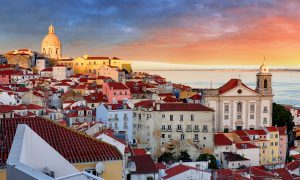Portugal, a country rich in history and culinary traditions, offers a unique gem in its vinous portfolio: Vinho Verde. This distinctive ‘green wine’, not green in color but ‘green’ in youth, hails from the verdant, northwestern part of Portugal and brings with it a light, fresh, and vibrantly acidic character that captures the essence of its cool, rainy region. This article delves into the enchanting world of Vinho Verde, exploring its traditions and the meticulous process behind its creation.
A Taste of Tradition: Unveiling Vinho Verde
Vinho Verde, directly translating to ‘green wine’ in Portuguese, denotes its youthful vigor rather than its hue. This name reflects the tradition of consuming the wine soon after bottling, capturing its freshest and most vibrant state. Vinho Verde is not just a type of wine but a deep-seated cultural emblem, originating from the historic Minho province, which boasts a wine-making history that stretches back over two thousand years. The unique climatic conditions of this region, characterized by abundant rainfall and moderate temperatures, create the perfect setting for producing these distinctive wines.
The region’s wine culture is built around small family vineyards and communal wine-making facilities, where age-old techniques are passed down through generations. The grapes used in Vinho Verde are native to Portugal, with Alvarinho, Loureiro, and Trajadura among the most popular. These varietals contribute to the wine’s light body and subtle effervescence, which is often naturally occurring, though some modern producers might add carbonation to enhance these effects. The traditional method involves very minimal interference during the wine-making process, preserving the natural flavors and acidity that Vinho Verde is renowned for.
Each sip of Vinho Verde offers a taste of Portugal’s lush landscapes and its people’s close bond with the land. The wine typically features floral and fruity notes, with a balance of sweetness and acidity that makes it exceptionally versatile for pairing with food. It’s especially favored during warm months due to its refreshing quality and is often accompanied by light dishes such as seafood, salads, or soft cheeses, mirroring the coastal diet of its region.
From Vineyard to Vino: The Making of Vinho Verde
The viticultural practices in the Vinho Verde region are a testament to the adaptation of local farming to the region’s wet, verdant terrain. Vine training systems are unique here; the vines are often trained high above the ground on trellises, which locals refer to as ‘vinhas de enforcado’ (hanged vineyards), allowing better air circulation around the grapes and reducing the risk of rot in such a damp climate. This method not only protects the grapes but also frees up the land beneath for other agricultural pursuits, showcasing an efficient use of space that characterizes Minho’s farming practices.
Harvesting the grapes for Vinho Verde is predominantly done by hand due to the intricate configurations of the trellises and the terrain of the vineyards, often steep and difficult to mechanize. This manual harvest ensures that the best quality grapes are selected, maintaining the high standards of wine production. After harvesting, the grapes are quickly transported to local wineries to prevent early fermentation, which could alter the delicate balance of flavors that define Vinho Verde.
The fermentation of Vinho Verde is carefully controlled to preserve its signature lightness and freshness. Temperature-controlled fermentation is a modern adaptation by many producers to maintain consistency and enhance the distinct profile of the wine. Following fermentation, Vinho Verde does not typically undergo aging; it is meant to be enjoyed young. The wine is often bottled within three to six months of harvest, ensuring that its youthful, vibrant flavors are retained when it reaches consumers across the globe.
Exploring Vinho Verde offers a window into the heart of Portugal’s rich viticultural heritage and its ongoing innovations. From the unique viticultural techniques to the communal and generational nature of its production, Vinho Verde is not just a wine but a celebration of culture, tradition, and the freshness of nature itself. Whether enjoyed in the bustling taverns of Lisbon or savored overseas, each glass of Vinho Verde carries with it the essence of the verdant, lively spirit of Minho, making it a must-try for wine enthusiasts and novices alike.

Gonzalo
Founder/Owner of The Lisbon Guide, one of the major blog references in Portugal, established in 2014 and receiving every year 250.000 visitors from all over the world, looking to provide the best experiences in Portugal. In partnership with Portugal Magik for all private tours and transfers across Portugal, Gonzalo loves a good seafood meal at Monte Mar Cascais, and all from Michelin Chef Avillez. Favorite Hotel in Lisbon/Portugal, Penha Longa Resort by Ritz Carlton.
For over 15 years, Gonzalo have been helping thousands of travelers yearly to plan a perfect trip to Portugal. Based in Lisbon/Cascais and working in this field for over 20 years, with multiple ongoing projects. Also an avid TripAdvisor user level 6 with more than 300.000 readers worldwide.
Many years working also as a Private Guide of Lisbon, Sintra, Fatima, Porto, Douro Valley, Evora, and other locations in Portugal.


















































